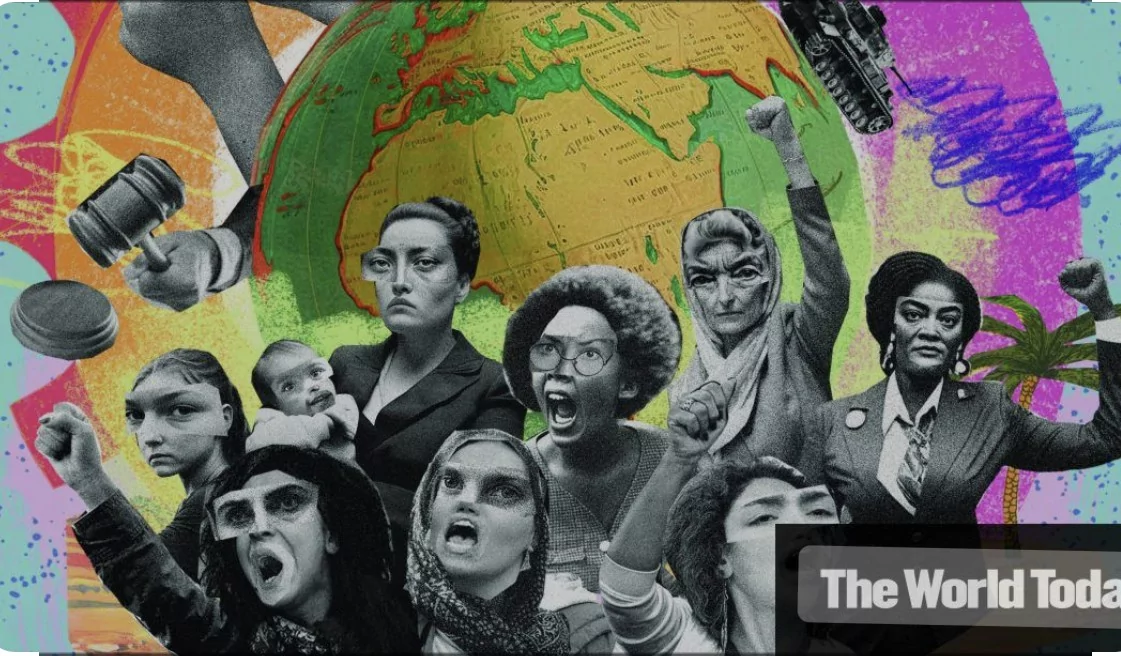By Margot Wallström
Excluding women from peace talks leads to less justice for them and a greater chance of conflict, writes Margot Wallström.
They are called ‘family photos’, official pictures taken at governmental, international and multilateral meetings, conferences and signing ceremonies in which dignitaries are lined up on a platform or staircase or simply arranged sitting around a table. Everything is staged. Everyone has an assigned place, with VIPs in the centre ground. All look serious and are suitably attired for the occasion. A black suit works fine.
Putting women in the picture
Yet all too often in these ‘family’ photos something is missing: and that is the women. Perhaps we are too familiar with men’s dominance at these top-level meetings that we take the absence of women for granted and fail to recognize it. But when women are left out of the picture, constrained or silenced in any way, it poses a serious threat to democracy.
A particularly clear example you may remember was when, three days after his inauguration, President Donald Trump signed an executive order at the big presidential desk in the Oval Office while a group of men gathered around him watching. In that moment, the president and his male colleagues reimposed the ban on American funding for any NGO that provided services or information on abortions. It prevented many health campaigners around the world from providing comprehensive safe advice and healthcare while jeopardizing the lives of tens of thousands of women.
For policies to support women in a meaningful way, women need to be at the table.
It has been more than 20 years since the adoption of UN Security Council Resolution 1325 on Women, Peace and Security in October 2000. That resolution called for the increased participation of women ‘in all efforts for the promotion of peace and security’. However, looking at its implementation often means revealing its failures.
Here is what I mean by that. Less than 10 per cent of peace agreements have female signatories. So, between 1990 and 2014, out of the 130 peace agreements reached, women signed only 13. This becomes ever more dangerous when you realize that sexual violence is used as a weapon in wars and conflicts all over the world.
The state of women’s rights around the world is bleak. In 104 countries, laws prevent women from performing certain types of work. Women lack the legal right to own land in many countries. Around 40 countries have no laws to protect women against violence in the home. In developing regions, 214 million women and girls lack access to contraceptives as conservative forces continue to try to limit and qualify their right to make their own decisions about their bodies and lives.
Recent peace agreements have not improved the situation. Women took no part in the peace agreement reached on Tigray in Ethiopia. We continue to receive reports from that country of the systematic use of sexual violence as a weapon of war as a form of retaliation, punishment, humiliation, or to stigmatize individuals because of their real or perceived ethnic identity.
In Yemen, enduring a bloody civil war since 2014, women are absent from peace talks. In Colombia, women were at first excluded, then had to fight hard to get a seat at the 2016 peace negotiations between the government and the FARC guerrilla army. When they succeeded, they introduced new perspectives into the process and put forward options to address gender inequalities in political participation and justice.
‘Nothing about us, without us!’
The beauty of the Security Council’s ‘mother’ resolution 1325 is its recognition of the different roles men and women play in situations of war and peace. It affirms that peace and security efforts are more sustainable when women are equal partners in the prevention of violent conflict, the delivery of relief and recovery efforts and in the forging of lasting peace. In other words, to borrow a phrase from disability rights activism, resolution 1325 formalizes the slogan ‘nothing about us, without us!’
The four pillars of resolution 1325 – protection, participation, prevention, and relief and recovery – offer a holistic view of women’s needs and challenges, including the specific and targeted security threats against women such as sexual violence. Eight consecutive Security Council resolutions have since addressed the global scourge of rape as a weapon of war.
We can apply the principles of resolution 1325 to analyse a few of the most atrocious conflict situations around the world today.
Women actively participate in the defence of Ukrainian territory. They fight alongside men, they suffer and die or they take care of children and the elderly when they have to flee. They love their country as much as their men do, but they are not as visible when it comes to communicating the resilience and resolve of the Ukrainian people, or as part of the political leadership’s press conferences. There was a rare occasion at the beginning of the war – not a real negotiation – when a Russian and a Ukrainian delegation sat down for discussion but yet again no women were present.
Protection for Ukrainian women in wartime has meant being helped to leave the country or be moved to other safer locations within Ukraine. It has placed on them a particular responsibility for the safeguarding of children and grandparents brought with them and has exposed them to the risk of being raped or trafficked. Already many have ended up in the hands of ruthless sex traffickers.
Sexual violence in conflict is a war crime
Prevention is difficult to address in the midst of a war and relief and recovery assistance is almost impossible to provide without the participation of women. My own experience from visiting post-conflict areas and talking to survivors of sexual violence is that they are often only willing to tell their horrifying stories to another woman. Despite the systematic use of sexual violence as a weapon of mass traumatization, many people view it as unavoidable, as something that cannot be spoken of, or as a relatively minor crime.
When women are left out of the peace process, the risk is that the treatment of instances of sexual violence as a war crime will not be raised. Impunity will continue to be the rule, and there will be no justice for its victims.
The backslide for democracy has also seriously affected the situation for women. The rise of autocratic rulers has led to restrictions on access to sexual and reproductive health and rights for women.
In Afghanistan women now describe their situation as ‘death in slow motion’, having been denied education, healthcare and jobs. They are not supposed to be visible, and the Taliban rule is cruel and oppressive. In Iran women have seen their life opportunities limited for decades. Their identity and rights have been taken away from them. As in Afghanistan, women have been silenced, imprisoned and murdered.
Yet in recent months the world has witnessed something extraordinary: a women’s movement in Iran, now spread to include men as well, from all walks of life. In both countries women are uniting and standing up for their rights. ‘Woman. Life. Freedom.’ has become the rallying cry around the world.
Foreign policy must be feminist
In 2014, when I announced as Foreign Minister that the newly formed Swedish government would pursue a Feminist Foreign Policy, I knew that it would be controversial. Why should foreign policy be feminist? The fact is that research shows that with more women involved in peace processes, more proposals are put on the table and agreements reached last longer. It is therefore correct to say ‘more women equals more peace’.
It is one thing to talk about arguments, but quite another to convert them into concrete action. As a Feminist Foreign Policy was new and unknown, not only to our administration but to the world, there was always the risk that the change would stop at rhetoric.
To counter this we designed a model around three Rs that became a guide in all our work. It was an advantage that the three Rs worked just as well when translated into English and the use of alliteration was helpful when communicating quite radical and complex new ideas to the staff at our embassies.
Rights, representation and resources
The first R is Rights. Do women and girls enjoy the same legal rights as men and boys? Do women have inheritance rights? Can a woman open a bank account or start a business? Are there child marriages? Can girls go to school? Are women legally allowed to drive a car? Are human rights also women’s rights? Is there discrimination against women?
The second R is Representation. Are women represented in governments? Are they at the table when important issues are discussed and decided? Are they on the boards of companies? Are there female judges in the judicial system?
The third R is Resources. Are resources being allocated to promote equal opportunities for all women and girls to enjoy human rights?
It was impressive how quickly we saw a great deal of enthusiasm from our diplomats. They took a professional pride in arguing for more gender equality in foreign policy − perhaps because reality provided all the necessary arguments. A country with a high proportion of child marriage finds it difficult to escape poverty. Outlawing violence against women increases wellbeing in entire societies.
An ambassador was appointed to promote the Feminist Foreign Policy and yearly action plans were implemented. Up to now, 10 other countries have followed our example.
It is a disappointment, of course, that the new conservative Swedish government, steered by a nationalist xenophobic right-wing party, has announced that it will no longer pursue this policy. But what I call the fourth R – the Reality check, namely, that without women’s rights and participation democracy and peace are weaker – is the strongest argument why I think the concept and, most importantly, the content will survive.
So, what can and should world leaders do, if not compare failures? An essential challenge has to do with gender-based violence. In the words of Antonio Guterres, the UN Secretary-General: ‘There is increasing recognition that violence against women is a major barrier to the fulfilment of human rights and a direct challenge to women’s inclusion and participation in sustainable development and sustaining peace.’
This means that much more has to be done to ensure that there is peace and security for women in their homes and everyday lives. And, who knows, maybe a feminist perspective on the root causes of conflict can help us redefine security beyond military strength while contributing to a much broader normative reorientation of the political agenda.
We will know we are seeing progress on women, peace and security when more women appear in our ‘family photos’.

